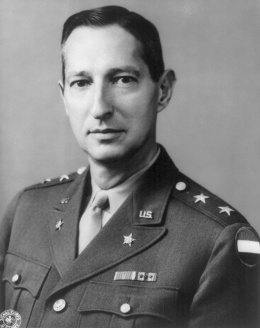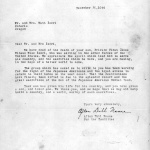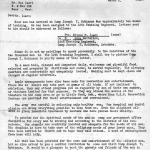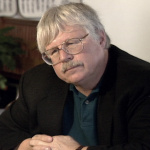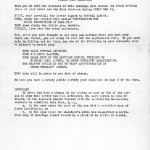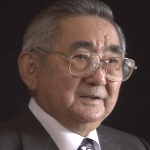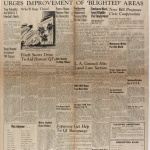Mark W. Clark
| Name | Mark Wayne Clark |
|---|---|
| Born | May 1 1896 |
| Died | April 17 1984 |
| Birth Location | Watertown, NY |
World War II commander of the Fifth Army and 15th Army Group in Europe, diplomat, college president. General Mark W. Clark (1896–1984) was among those army leaders who opposed mass incarceration of West Coast Japanese Americans on pragmatic grounds. He later commanded Nisei troops in the 100th Infantry Battalion and 442nd Regimental Combat Team and remained a staunch advocate of those units and of Japanese Americans in general throughout his life.
Career Soldier
Mark Wayne Clark was born on May 1, 1896, in Watertown, New York, the son of U.S. Army Colonel Charles C. Clark and Rebecca Ezekiels. Col. Clark served in Puerto Rico, the Philippines and China prior to World War I. Mark followed in his father's footsteps, entering West Point in 1913 and graduating in April 1917. Commissioned into the army, he served in World War I and was wounded in France. He remained the army, serving in various posts through the '20s and '30s and acquired additional training at the Infantry School's Advanced Officers Course at Fort Benning in 1924, the Command and General Staff College at Fort Leavenworth in 1933 and the Army War College in 1936.
He was subsequently posted to Fort Lewis, Washington, where he renewed acquaintances with George C. Marshall , who he had known since serving together in World War I. When Marshall was named army chief of staff, Clark went with him as assistant chief of staff for operations and was promoted to brigadier general in August 1941.
Wartime Military Commander
In weeks after the attack on Pearl Harbor, Marshall assigned Clark two tasks that might have had an impact on the decision to incarcerate all Japanese Americans on the West Coast. In both cases, his conclusions that directly or indirectly opposed exclusion were largely ignored. In the first instance, Marshall sent Clark to visit the Western Defense Command in response to its commander, General John DeWitt 's call for more troops with which to defend the West Coast. After five days of study, he reported to Marshall on Jan. 27, 1942 that the "theater of operations" designation (set on Dec. 11) be removed for tactical reasons, since "all that is needed to protect the West Coast is a functional command with the mission of defending the coastal frontier against air and naval surface raids." DeWitt and Army Provost Marshal General Allen Gullion objected, in large part because such action would endanger their efforts to remove all Japanese Americans from the West Coast. [1]
A few days later, on Feb. 3, he testified before a House-Senate Committee on Defense of the West Coast chaired by Sen. Rufus Holman of Oregon. Along with Chief of Naval Operations Harold Stark, he stated that "an invasion effort was out of the question" and that the most that the enemy was capable of would be "to possibly have a submarine throw a few shells into some city which would be a futile operation from the standpoint of practical results." [2] His dismissal of the possibility of a Japanese invasion of the West Coast was consistent with reports from army intelligence and seemingly undercut one of the main rationales for mass exclusion of Japanese Americans.
Clark's second and related assignment was to investigate what should be done with Japanese Americans on the West Coast from a military planner's perspective. By early February of 1942, he had come to the conclusion that the mass removal of Japanese Americans being proposed by DeWitt and his advisors was ill-advised and "expressed disbelief" when DeWitt informed him of these plans on February 12. Citing the manpower demands on the army in a mass removal scenario—he believed that 10,000 to 15,000 soldiers would be required to guard just the incarcerated alien group—he argued instead for identifying "critical installations" to be protected by evicting enemy aliens around their perimeter. He also recommended that "ring leaders and suspects should be interned liberally" and also frequent raids and counterpropaganda. But his more reasoned proposal came along too late, as the more draconian mass removal scenario had already been approved by the President and Secretary of War Henry Stimson , neither of whom asked the opinions of Generals Clark or Marshall. [3]
In January of 1943, now Lieutenant General Clark was named commander of the Fifth Army and led the Allied offensive in Italy. Among the soldiers under his command was the 100th Infantry Battalion, made up of Japanese Americans from Hawai'i. Initially rejected by General Dwight D. Eisenhower, Clark took them on willingly and soon became their "most enthusiastic supporter," citing their "efficiency" and "quick reaction to hostile opposition" in their initial encounters with the enemy. [4] In his autobiography, he recalled that the 100th was "... one of the most valuable assets in the Fifth Army" and that they "fought magnificently throughout the Italian campaign." "The Nisei troops seemed to be very conscious of the fact that they had an opportunity to prove the loyalty of many thousands of Americans of Japanese ancestry," he added, "and they willingly paid a high price to achieve that goal. I was proud to have them in the Fifth Army." [5]
Over Clark's objections, the 100th and 442nd Regimental Combat Team (which incorporated the 100th) were transferred to France to help take the Vosges Mountains in September of 1944. In an effort to prevent this, he proposed to Marshall that the 100th be broken off from the 442nd and remain with him, while the 442nd would be sent to France, arguing that the publicity effects would be multiplied in such a scenario. "It is difficult for me to exaggerate the ride I have experienced in having the 100th Infantry Battalion in the Fifth Army," he wrote them in a farewell letter. "I want to express to you my sincere appreciation for the superb job that you have done, and wish you every success in your new undertakings." [6] Later, in April 1945, the 442nd returned to Italy and served under Clark—who was now commander of the Fifteenth Army Group in charge of all Allied forces in Italy—for the remainder of the war. Clark took the German surrender of Italy on May 2.
Postwar
After the war, he served as high commission of Austria and as commander in chief of the United Nations Command in Korea before retiring from active duty in 1953. He subsequently served as president of The Citadel, a military college in South Carolina, for eleven years, retiring in 1965. Though a staunch anti-communist and an opponent of the civil rights movement, he remained a supporter of Japanese American soldiers, testifying before the Commission on Wartime Relocation and Internment of Civilians , "The well-publicized bravery, dedication, and brilliant achievements of the 442d Regimental Combat Team aroused the admiration of the American public at the time and brought home the fact that Japanese Americans, too, were loyal citizens and could and would fight for our country at least as well as any others.... It is not too much to say that within the space of a few months this small military unit convinced most Americans of their individual merit as citizens." He died on April 17, 1984.
For More Information
Asahina, Robert. Just Americans: How Japanese Americans Won a War at Home and Abroad . New York: Gotham, 2006.
Bischoff, Gunter. "Mark Wayne Clark." In American National Biography, Volume 4 , general editors John A. Garraty and Mark C. Carnes: 940–42. New York: Oxford University Press, 1999.
Childress, David. "Mark Wayne Clark." In Dictionary of American Military Biography, Volume I, A–G , edited by Roger J. Spiller: 180–82. Westport, Conn.: Greenwood Press, 1984.
Clark, Mark W. Calculated Risk . 1950. New York: Enigma Books, 2007.
Daniels, Roger. Concentration Camps, North America: Japanese in the United States and Canada during World War II . Malabar, Fla.: Robert E. Krieger Publishing Co., 1981.
———. Prisoners Without Trial: Japanese Americans in World War II . New York: Hill and Wang, 1993.
Muller, Eric L. "Hirabayashi: The Biggest Lie of the Greatest Generation" (August, 18 2008). UNC Legal Studies Research Paper No. 1233682. Available at SSRN: here or here.
Tsukano, John. Bridge of Love . Honolulu: Hawaii Hosts, Inc., 1985.
Footnotes
- ↑ Eric L. Muller, "Hirabayashi: The Biggest Lie of the Greatest Generation" (August, 18 2008). UNC Legal Studies Research Paper No. 123368238.
- ↑ Muller, "The Biggest Lie," 41–42.
- ↑ Roger Daniels, Concentration Camps, North America: Japanese in the United States and Canada during World War II (Malabar, Fla.: Robert E. Krieger Publishing Co., 1981), 65–67; Roger Daniels, Prisoners Without Trial: Japanese Americans in World War II (New York: Hill and Wang, 1993), 44.
- ↑ Robert Asahina, Just Americans: How Japanese Americans Won a War at Home and Abroad (New York: Gotham, 2006), 74.
- ↑ Mark W. Clark, Calculated Risk (New York: Enigma Books, 1950, 2007), 180.
- ↑ John Tsukano, Bridge of Love (Honolulu: Hawaii Hosts, Inc., 1985), 215.
Last updated Dec. 16, 2023, 11:17 p.m..

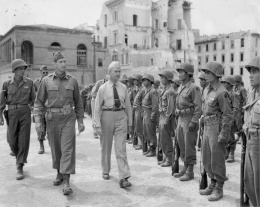 Media
Media
